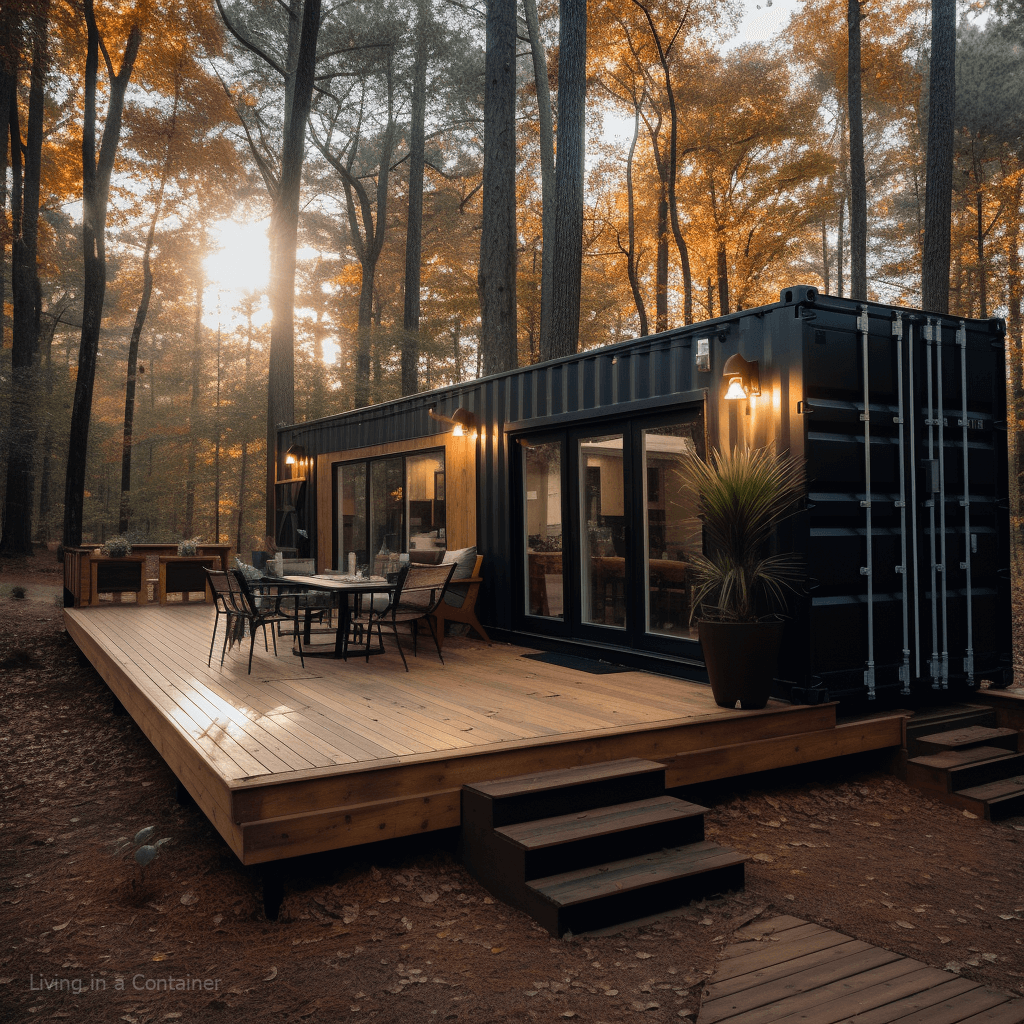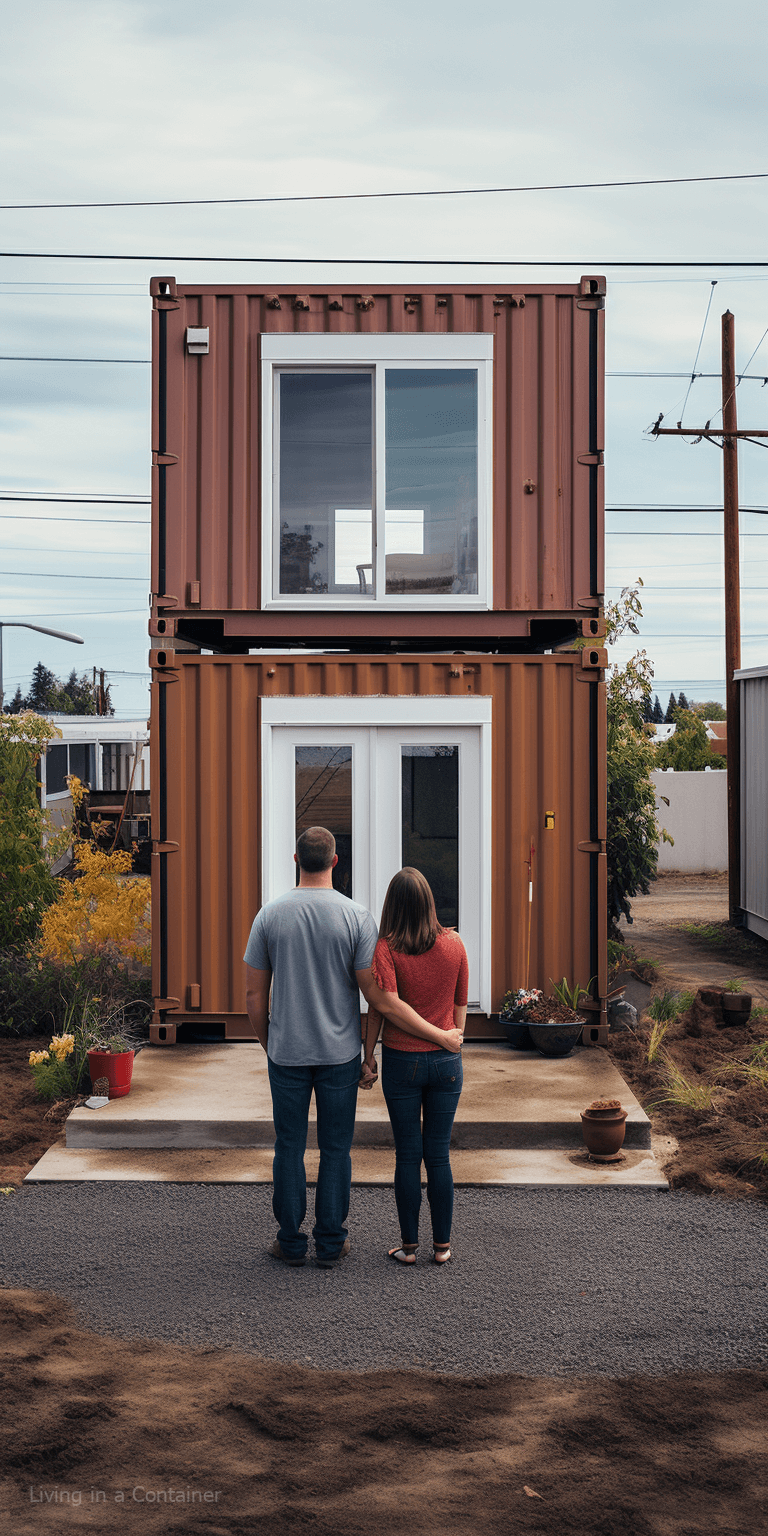Determining whether a permit is required to place a shipping container on one’s property is not always straightforward. Generally, local building codes and zoning laws play a significant role in deciding if a permit is necessary.
Many regions adhere to the International Building Code (IBC), and in such areas, a shipping container is usually subject to the same building regulations as any other structure, indicating that a permit is often required.

The need for a permit also hinges on the intended use of the shipping container. If the container will be used for storage or as a temporary structure, some districts may not require a permit, provided it does not become a permanent fixture. In contrast, if the container is to be converted into a residence or a permanent backyard installation, then a permit will likely be mandatory.
Moreover, placement and usage play crucial roles. For instance, whether a shipping container is being used as part of a construction project or simply for storage could affect the permitting process.
Local zoning laws, property zoning, and specific county rules are all factors to consider. Container owners should consult with local government authorities to determine the necessity of a permit and to ensure that all regulations are being met.
Proper understanding of these regulations can save time and prevent potential legal issues, so it is essential for property owners to be familiar with local zoning laws and building codes before installing a shipping container.
Understanding Zoning Laws and Regulations
When considering placing a shipping container on your property, it is crucial to understand and adhere to local zoning laws, building codes, and other regulations to ensure legal compliance and mitigate potential issues.
Local Zoning Requirements
Zoning laws vary by municipality and dictate how a property can be used. It is essential to check with your city or county’s planning department to determine the zoning requirements specific to your area. This includes restrictions on the type of structures allowed and where they can be placed on your property.
Building Codes Compliance
Adherence to building codes, including the International Building Code (IBC) and International Residential Code (IRC), ensures that any structure on your property is safe and structurally sound. Building codes cover various aspects ranging from design to construction materials and techniques.
Homeowners Association and Deed Restrictions
For properties governed by a homeowner’s association (HOA), it is necessary to review HOA rules and deed restrictions, which may impose additional limitations beyond city ordinances.
Permitting Process Overview
Securing a permit generally involves submitting specific plans for approval, and a permit expediter can assist with navigating the process. Some areas may require a temporary use permit for short-term structures.
Container Size and Property Layout
The container size and property layout are factors in meeting zoning laws. Placement on the property should comply with lot size dimensions and setback requirements.
Safety and Structural Considerations
Shipping containers must be structurally sound and may require modifications to meet safety regulations. Inspections may be mandated to ensure compliance.
Temporary vs. Permanent Structures
Local laws differentiate between temporary and permanent structures, affecting the need for permits. A container used temporarily, like for storage, often has different rules than one intended for habitation.
Additional Local Council and Government Requirements
Beyond zoning and building codes, additional local council and government requirements may exist, such as environmental assessments or public utility guidelines.
Potential Confusions and Misconceptions
Misunderstandings commonly arise regarding permits for structures like sheds, fences, or landscaping features compared to shipping containers. Legal advice can clarify these points.
Accessory Structures and Secondary Uses
Containers often serve as accessory structures or have secondary uses, such as a workspace or shed, which may be subject to distinct rules within the zoning code.
Living in a Shipping Container Home
Turning a container into a primary dwelling requires meeting criteria similar to traditional homes, including sufficient living spaces and necessary utilities like plumbing and electrical power.
Utility Connections and Services
When modifying a shipping container for living, connections to essential services like water, sewage, and electricity must comply with local regulations and codes.
Aesthetic and Community Impact
The aesthetic impact of a shipping container, particularly in residential areas, is a concern for many local authorities, so considerations for the container’s exterior appearance are often part of the permitting process.
Environmental Consideration and Sustainability
Using shipping containers can be seen as sustainable and eco-friendly due to their durability and the repurposing of existing materials, which aligns with some municipalities’ emphasis on environmental concerns.
Required Permits for Shipping Containers
When considering the placement of a shipping container on a property, prospective owners must navigate a variety of permits, ensuring compliance with local and international codes. Permit requirements vary based on the intended use, duration, and local municipality rules and regulations.
Types of Permits for Containers
Different permits may be required depending on the shipping container’s use. While some locales may not require a permit for temporary storage, any form of permanent or habitable construction will typically necessitate a building permit. It’s essential to research municipality-specific zoning laws and code requirements to determine whether a storage container permit or a temporary use permit applies.
Permit Application Process
The permit application process entails submitting specific documents to the local municipality. These documents often include detailed plans of the container’s placement and intended use. Applicants should allow for ample time to conduct research and gather necessary data to ensure compliance with all codes and regulations.
Permit Costs and Fees
Fees for shipping container permits can vary significantly. The cost typically depends on the container’s size, location, and duration of use. Some municipalities may charge a static fee, while others calculate the cost based on the project’s scale.
Inspection and Approval Stages
After submitting a permit application, the inspection and approval stages begin. This often includes on-site inspections by officials to guarantee that the container adheres to code requirements. Successful navigation through these stages results in permit approval.
RELATED
- How To Extend Your House With A Shipping Container
- Shipping Container Home Installation: Everything You Need to Know
- How Much is a Used Shipping Container: Cost Factors and Pricing Guide
Permit Expediter Services
Individuals can enlist permit expediter services to streamline the approvals process. These services are knowledgeable about local codes and can maneuver through the bureaucratic process more efficiently, potentially reducing the wait time for permit issuance.
Understanding High-Hazard Group H Occupancy
When a container is used for storing materials classified under High-Hazard Group H, specific permits and building permits with stringent regulations are required. Compliance with these codes is crucial for legal and safety reasons.
Special Regulations for Commercial Properties
Commercial property guidelines often differ from residential codes. This may include additional permit requirements or rezoning actions, particularly if the container alters the property’s current use classification.
Rezoning for Shipping Container Usage
In some cases, rezoning might be necessary. This process involves changing the area’s official zoning laws to accommodate the container’s intended commercial or residential purpose.
Impact of Cargo and Storage History
Permits might also be influenced by the container’s cargo and storage history, especially if the unit previously transported hazardous materials. This could necessitate a more rigorous inspection and approval process.
Guidelines for Temporary Storage Containers
Containers categorized for temporary storage typically face less stringent permitting processes. Nevertheless, it’s important to check municipality rules and regulations for any specific requirements related to duration and placement.
Regulations for Growing Plants Inside Containers
When modifying a container to grow plants indoors, additional permits may be required, especially if alterations are made to the structure for ventilation, electrical, or plumbing systems. Local codes will dictate these permit requirements.
In conclusion, securing the appropriate permits for a shipping container is an intricate process that demands diligence. Understanding and adhering to the established legal framework and municipality regulations ensures that property owners remain compliant and avoid potential legal challenges.
Placement and Installation Considerations
When considering the placement and installation of a shipping container on one’s property, there are several critical factors to address. These include determining the optimal site for the container, adhering to foundation and anchoring regulations, ensuring adequate space for access and maneuvering, and deciding the container’s orientation and entry points.
Determining the Best Location
The best location for a shipping container is typically a flat, stable surface that is easily accessible from adjacent streets to facilitate delivery. This physical location should be strategically chosen to minimize safety risks and avoid high-traffic areas while complying with any local requirements for placement on the property. Prior to installation, verifying whether a permit is necessary is crucial, as regulations can vary significantly.
Foundation and Anchoring Requirements
For a permanent container structure, setting a proper foundation is necessary to maintain stability and levelness over time. Depending on local building codes, this may involve pouring a concrete foundation or using a gravel base. Anchoring the container is also vital for safety, especially in regions prone to strong winds or seismic activity.
Access and Maneuvering Space Needed
Adequate access involves ensuring there’s enough space for delivery trucks to navigate to the placement site without damage to the property or surrounding infrastructure. The required space for maneuvering the container into position will differ based on the size of the container and the type of delivery vehicle used.
Shipping Container Orientation and Entry Points
The orientation of a shipping container should consider the entry points, solar exposure, and the flow of traffic around the container. The doors should ideally face towards a low-traffic area to facilitate safe and easy access without interfering with the functionality of the backyard or property space.
Using Shipping Containers for Storage
When considering the use of shipping containers for storage, it is crucial to understand the legal requirements and how to effectively secure and utilize the space. Regulations can vary, but generally, a permit may be necessary, and proper safety measures should be in place to ensure secure storage on your property.
Legal Implications for Storage Use
Obtaining a permit for a shipping container typically depends on local building codes and zoning laws. It’s essential to verify whether your intended storage use complies with these regulations. Without proper documentation, you may face fines or be required to remove the container.
Security Measures and Locking Systems
For shipping containers used for storage, security is paramount. Incorporating robust locking mechanisms is advised to safeguard contents. High-quality padlocks, crossbar locks, or hidden shackle locks are common choices to prevent unauthorized access and theft.
Storage Containers as Tool Sheds or Workshops
Shipping containers can serve as excellent tool sheds or workshops due to their durability. However, modifications for storage purposes must adhere to local guidelines. Furthermore, to maintain efficacy, it’s essential to organize tools and equipment efficiently for easy accessibility.
Limitations on Contents and Uses for Storage
Certain limitations may apply to what can be stored inside shipping containers. Generally, hazardous materials are prohibited. For storage purposes, it is critical to ensure that the container’s contents are permissible under local laws and do not present any safety risks.
Climate Control in Storage Containers
Depending on your storage needs, climate control within the container could be necessary. For temperature-sensitive items, insulation, ventilation, or air conditioning may be installed. Keep in mind that these modifications often require additional permits and should comply with safety standards.
Ownership and Rental Options
Deciding between buying and renting a shipping container for your property hinges on long-term requirements and financial considerations. It’s crucial to navigate legalities like permits and HOA rules and assess whether the container will serve as static storage space or a more flexible fixture such as a rental home.
Buying versus Renting a Shipping Container
Buying a container offers the advantage of ownership; the container can be modified and used without the restrictions typically imposed by rental agreements. This option suits those seeking a long-term storage solution on their property.
In contrast, renting a container provides flexibility without the commitment of a purchase. It is ideal for temporary storage needs or when future property plans are not fixed. Renting can also circumvent some permit requirements, as the container is not a permanent fixture.
Considerations Before Purchasing
Before purchasing a shipping container, research is paramount to ensure compliance with local legal regulations. Prospective buyers should:
- Verify zoning laws and permits required for containers on residential property.
- Investigate HOA rules that may affect container placement and use.
- Assess the suitability of the property as a storage space or potential rental home.
Contractual Obligations and Rental Agreements
Rental agreements delineate the terms under which a container can be placed on a property. These contracts often include:
- Duration of the rental period.
- Maintenance responsibilities.
- Conditions for returning the container.
It’s essential to understand these obligations to avoid legal issues and ensure that the container serves its intended purpose—be it storage or as a habitable space.
Legal and Compliance Issues
When considering the placement of a shipping container on one’s property, it is crucial to navigate through the maze of legal and compliance aspects. Owners must ensure they adhere to various building regulations, code requirements, and standards of construction dictated by both domestic municipalities and international guidelines such as those established by the International Code Council.
Potential Penalties for Non-Compliance
Non-compliance with municipal government regulations related to shipping containers can lead to substantial penalties. These may include fines, forced removal of the container, or other legal actions. It’s imperative to obtain the necessary permit and adhere to local code requirements to avoid these outcomes.
Resolving Disputes with Neighbors or Municipalities
Disputes concerning a shipping container may arise with neighbors or local authorities. If one does not comply with building regulations and codes, they must be ready to face legal actions or be required to engage in dispute resolution processes, sometimes including mediation or legal hearings, to retain their shipping container on-site.
Adhering to International and Domestic Standards
Compliance with both international guidelines set out by entities like the International Code Council and domestic construction standards is non-negotiable. International standards often influence local building regulations and one must ensure their shipping container meets these requisite standards of construction.
Public Street and Community Considerations
The placement of a shipping container can also affect public streets and community aesthetics. One must consider local laws regarding public right-of-way, visibility, and safety to ensure that the container does not impede daily life or infringe upon community standards. It is not just about individual compliance but about being a responsible member of the community.
Design and Customization

Designing and customizing a shipping container for property use involves considering the structure’s foundation, its intended occupancy, and how it blends with existing features or buildings. This customization can provide an affordable and flexible storage space or living area that caters to specific needs, whether placed in a Portland, Oregon backyard or beyond.
Customizing Containers for Specific Needs
Shipping containers are renowned for their robustness and modularity, which allows for significant customization options. They can be tailored for various uses ranging from simple storage spaces to complex residential dwellings. For instance, the foundation of a container can be fortified to support additional weight, or interior walls can be modified for distinct occupancy requirements.
- Storage Solutions: Shelves, racks, and hooks for efficient organization
- Living Spaces: Insulation, windows, and electrical installation for comfort
Integration with Existing Buildings or Features
A shipping container can be stylized to match or complement the exterior of existing buildings, ensuring visual harmony in any setting. By using materials and design elements that reflect the surrounding architecture, container units can seamlessly integrate into a location, maintaining the aesthetic balance of the property.
- Exterior Choices: Paint, cladding, or branding to align with property design
- Landscape-Friendly Footprint: Placement that respects the natural features of the backyard or land
Creating Modular and Expandable Spaces
The innate flexibility of shipping containers allows property owners to create modular designs that can evolve over time. These structures can be easily expanded by adding more units, making them an affordable solution for growing businesses or households.
- Multi-Unit Configurations
- Single-Level Spread: Various containers spread across the property
- Stacked Arrangements: Containers placed atop one another for a compact footprint
Case Studies and Examples

In exploring the practicalities of using shipping containers on private property, it’s enlightening to examine real-world scenarios. These case studies provide a concrete understanding of the legalities and processes involved.
Portland, Oregon: A Case Study of Container Usage
Portland, Oregon stands as a compelling example of incorporating shipping containers into urban and residential areas. The city’s progressive stance on alternative housing has embraced the use of containers as affordable and sustainable homes. Residents who are interested in constructing container homes must navigate a series of permits and legal requirements to ensure compliance with local building codes.
- Permitting Process: Obtaining a permit in Portland requires an understanding of the Residential Code which governs container homes like any other residential construction. Applicants present their construction plans, which must include details on insulation, electrical work, and plumbing to the city’s Bureau of Development Services.
- Zoning Regulations: Portland’s zoning code determines where container homes may be situated. Residential zones typically allow for such structures, but it is essential to verify this with the local zoning maps.
Case Outcomes: Many have successfully transformed shipping containers into habitable structures in Portland, helping to address housing affordability while adhering to the city’s regulations. The process, while thorough, is streamlined for those who provide the requisite detailed plans and comply with the necessary building codes.
FAQs and Expert Tips

When considering the placement of a storage container on one’s property, key factors such as legal requirements, permits, and regulations must be addressed.
Top Questions Answered by Experts
Q: Does one always need a permit to place a storage container on their property?
A: It is not always necessary to obtain a permit for a storage container. However, compliance with local building codes and zoning laws is essential. Local county authorities should be consulted to confirm permit requirements.
Q: What dictates the need for a permit when installing a storage container?
A: The need for a permit often stems from the International Building Code (IBC) or similar regulations. The specifics can vary based on the state or the intended use of the storage container. Zoning of property is another factor that influences permit requirements.
Q: Can a shipping container be used for storage on residential property without legal issues?
A: The legal use of a shipping container for storage depends on local rules, which can occasionally allow for such use without significant legal barriers. However, it is prudent to verify the local regulations to ensure compliance. Local zoning laws and building codes provide specific guidance on this matter.

No Responses